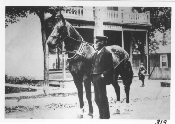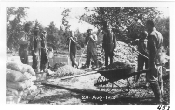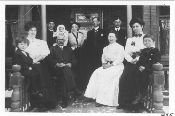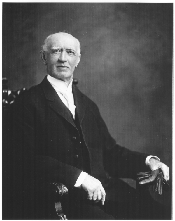The Village that Was
 |
| James Graham and
"Barney," in front of
Hall's grocery
and general store, southwest corner of
Yonge and
Centre streets,
circa 1915. |
 |
| Fixing the dam at the
Mill Pond.John Sheardown
is pictured centre-right, behind the wheelbarrow. |
Let us walk along
Yonge Street with
Dorothy
McKenzie Rumble as she re-creates the village of her childhood. Dorothy
takes us back to 1912, and makes frequent comparisons with the town of the late
1950s, as she records her impressions for the
Richmond
Hill Women's Institute history project.
Dorothy's memories of 1912 start at the
Presbyterian Church, where both her grandfathers had taken
a turn at being caretaker, and where she herself sang in the choir. Behind the
church stood the old
cemetery which was often visited by
public
school students at recess. "It was such an easy matter to jump the
fence," Dorothy remembers.
Between the
Presbyterian Church and the Public School back in 1912 were
two shoemakers,
Mr. Kennersley and
Frank
McConaghy, and a watchmaker,
Jerry Smith.
Immediately north of the school was the Post Office, whose venerable master,
Matthew Teefy, had
died the previous year. Next was the
Palmer House
Hotel, which later became the
Arnold
Apartments.
In the
Lorne Block, Dorothy
remembered
"Aunt Mary Ross as she
was known to many," and the harness shop of
George McDonald.
The next store was
J.P. Glass's
Butcher Shop, with the slaughter house in the rear.
 |
| The P.G. Savage family of
Richmond Hill,
pictured in 1909. Left to right are
Palmer (son of Will),
Mrs.
Will (Palmer) Savage,Armand with his son
Peter,Susan (Mrs. Armand) Savage,Albert,William, and
Mrs.
Albert Savage with her
son
Keith. Seated are
P.G.
(Peter Gould) Savage and his second wife,
Theodora Hillman Savage. |
 |
| Dr. W.R.
Pentland practised medicine in
Richmond Hill
from 1910 until he retired to California in 1919. |
North of
Glass's Butcher
Shop - when Dorothy was a young girl - stood the hardware store of
Jacob Eyer, which
became the
Rustic Inn. Next was
Atkinson and Switzer General Store (later
Fisher's). On the south
corner of
Centre Street was the
grocery store of
Joseph Hall (later
the location of the Post Office). On the north side of
Centre was a brick
house, then the furniture and wallpaper store of
P.G.
Savage. Next came
William
Harrison's saddlery (later
Isobel "Izzie"
Hewitt's Wool Shop), followed by the
Jesse Grant
residence.
Dorothy continues north, making many comparisons
between 1912 and the late 1950s. Where
Craigie's
store later stood was the home of
Mr. Ellis, a house
painter. On the former Sunoco lot was
Abraham Law's
original house, later the residence of his son-in-law,
Amos J.
Wright. Next was
Fred Allen's home,
where there was a magnificent garden (now the
Langstaff
Building).
Richmond Hill
High School, later incorporated into the town hall, stood at the corner
of
Wright Street.
North of
Wright Street,
Dorothy remembered five or six houses, then the blacksmith shop of
George Cowie, then
Dr. Langstaff's
and three more houses, and the funeral home.
At that point, Dorothy turns around, retraces her
steps back to the south end of town, and takes us across
Yonge Street.
On the east side of Yonge a short distance north of
Markham Road(Major Mackenzie
Drive), opposite the
Presbyterian manse, was the
Brick Tenement, a
long building with three units, once the home of
Susannah
Maxwell. A short distance north was the long red brick building which
had been the
Grand Central
Hotel, and about 1911 was the Standard Bank and the office of H.A.
Nicholls, who owned the building. North of this was a building which housed the
offices of The
Liberal. Then came the
old
Dominion Hotel
building.
Trench's Carriage Works followed, and the
Metropolitan
Radial Station. Next to the station was
the grocery
store of Frank Sims, later
Wilson's Barber
Shop. The residence and store of
Alex Moodie was next,
and then
Morley's Grocery
Store and
Skeele's
Jewellers. A hardware store was operated by
Mr. C. Soules, later
Charlton's.
Then
Sanderson's, the
Methodist (United) Church, the
Masonic Hall,A.J. Hume's tailor
shop, and a short distance north,
H.H.
Hopper's butcher shop.
North of
Dufferin (later
Dunlop Street) was
David Hill's
bakery. A small house stood between this and the
Roman Catholic Church. Further north still was the home of
Isaac Crosby.
Along the streets leading away from Yonge, on both
the east and west sides of town, Dorothy remembers a rather sleepy village in
1912. "On the side streets were many vacant lots," she concludes, "a field or
two often separating the houses."
Richmond Hill Women's Institute,"Tweedsmuir History"(Richmond Hill:1957),unpaginated
|

